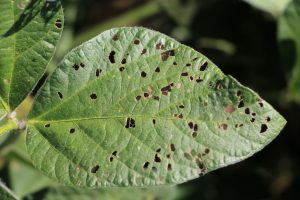Healthy Soils Suppress Insects and Disease
By James Hoorman, Hoorman Soil Health Services
Plants rely on soil microbes to feed them and keep them healthy. Most soil microbes are starving for carbon and plant sugars, so the area right around the root, called the rhizosphere is full of soil microbes that are competing for plant food (root exudates). Plant roots secrete up to 40% of their plant root reserves to feed microbes. The rhizosphere may have 1000-2000X more microbes than the surrounding soil without roots. Each microbe is a soluble bag of fertilizer! In order to get fed, these microbes have to bring something back to trade with the plant roots. Plant roots select, “farm”, or enhance microbial populations that feed them the best. Generally, this is a specific mineral or water needed for plant growth, or even antibodies to keep a plant safe from insects and disease.
If you want plants that are healthy and free of pests, make sure they have adequate mineral nutrition. However, you can fertilize a plant well, and still get insects or disease pressure because the minerals needed by the plant are in the wrong form or you do not have the right microbes. Today, we over fertilize our crops and yet we do not have healthy plants or get higher yields. Soil conditions like compaction, erosion, tight soils that do not drain, and lack of soil organic matter reduce plant nutrition and mineral uptake. Plants that not healthy are susceptible to insect and disease infection.
Many microbes we call pathogens are not always harmful. If the soil has a diverse microbial community, these pathogens can be harmless or have beneficial properties. The success of a pathogen is influenced by the total soil microbial community. Healthy soils have the ability to suppress disease causing pathogens and is called general disease suppression. Many organic amendments (compost, humic compounds, etc) may stimulate microbial activity and diverse microbial populations to enhanced general disease suppression.
How do the microbes suppress disease? Many human medicines like penicillin originated from soil microbes. Soil microbes produce antibodies to fight off disease but also out compete pathogens for energy and nutrients. Microbial diversity keeps the pathogenic population low enough so the plant can fight off any negative effects associated with disease organisms. Sometimes the beneficials produce specific enzymes that cause the pathogen’s cell wall to break down, which limits the pathogen population from expanding. Specific soil microbes induce disease suppression which is the most effective way to avoid plant disease.
Many beneficial soil microbes provide plant defenses above ground. This induced systemic resistance (ISR) allows the plant immune system to be primed for an insect or disease invasion. Plants can communicate with each other through the mycorrhizal root network and give off hormonal signals when an insect or disease invasion occurs. Insect feeding opens the plant up to a pathogenic disease invasion, so these two pests often work together. Many beneficial fungi like mycorrhizae and Trichoderma spp. and other fungal biocontrol agents increase ISR in plants. Insects do not attack a healthy plant because they can not digest the complete proteins produced in a healthy plant.
In unhealthy soils, each plant is on its own to fight insects and diseases. Often it starts with a couple of sick plants that are attacked by insects and disease, but after a while, all plants seem to get sick. Plants that fight together in a healthy soil have the ability to resist insects and disease invasions. Usually, this is because they are healthy and have plenty of beneficial microbes supplying the micronutrients or ammunition plants need to resist the invasion.
Plant-associated bacteria can also send signals to regulate plant gene expression. Such cell-to-cell communication is known as ‘quorum sensing’. A single plant gene which is expressed can alter the microbial community in a positive or negative way. Unfortunately, these plant genes may get turned off, especially in crops that have been genetically modified (GM).
Farmers may notice different weed species or disease that become more prevalent after a GM crop is grown. A single altered plant gene can shift the microbial biome to initiate these problems. Often GM crops have several or many altered genes, so scout your GM crops closely. Ideally, plant breeders should try to breed plants and cover crops to suppress insects and disease like what happened in developing oats crown-rust resistance. However, this may not always be the case, due to unintended consequences. Information from “The rhizosphere microbiome and plant health” (August 2012) and from article by BV Badri et al 2009.